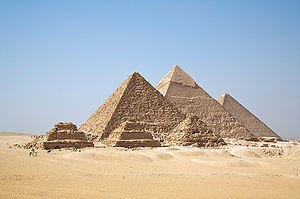Introduction
The Egyptian pyramids are prehistoric pyramid-shaped stonework structures found in Egypt. Currently, there are 138 known pyramids available in Egypt. The purpose of the construction of most of the pyramids was that they were to be used as tombs. Only an individual whose lineage was from a royal family could use these tombs for burial. The most primitive Egyptian pyramids are in Saqqara. Saqqa is in the northwest of Memphis.
The earliest pyramid was built in the pyramid of Djoser. According to archaeologists, its construction took place during the third dynasty (Smyth 45). Giza is the home of legendary pyramids. They are the largest masonry ever created in the periphery of Cairo. The aim of writing this paper is to describe the pyramids of Egypt and their sociocultural representations.
People believed that the shape of the pyramids came from the shape of the sunrays i.e. descending. Pyramids are on the west bank of the river Nile. The west bank of the River Nile is the side of the setting sun, as the locals know it. This site is also associated with the dead, as it is called the “territory of the dead.” According to the locals, pyramids protect the souls of dead pharaohs (Hawass 153).
Social depiction of the pyramids
The pyramids of Egypt refer to the stratification of the Egyptian social classes. These classes involved slaves, farmers, craftsmen, scribes, priests, doctors and engineers, high priests, nobles, viziers, and the pharaoh. Slaves refer to people who work without any need for appreciation. The bottom of the Egyptian pyramid represents this class. It formed the greatest percentage of the population in Egypt. Farmers follow the slaves in the strata. Just above the slaves and farmers were the craftsmen. Craftsmen refer to individuals with certain skills in society. This skill was to help the whole society. Craftsmen, unlike the slaves, received a token for their hard work.
The next group in the hierarchy is the scribes. The priests, Doctors and engineers, high priests, nobles, vizier, and the pharaoh were on top of the scribes in that order. The pharaohs were rulers of Egypt and came from the family bloodline of the previous ruler. Their responsibilities included ensuring that Egyptians are successful in all wars and making sure that the society followed state rules. Pharaohs were the final judge when it came to passing decisions about government issues (Nardo 32).
Beliefs about the pyramids
Early Egyptians believed that the pharaohs transformed into Osiris (King of the dead) upon their death. They were sure that these dead pharaohs were still their rulers from the spiritual life. This made them believe in protecting the pharaoh’s spirit in their death. This they did by mummifying the dead pharaoh and then burying them in the pyramids. The ancient Egyptians included, together with the mummy, other things that they would need.
These included vessels made of gold and clay. The dead pharaoh received food, from the locals, in the pyramid regularly for a long time after burial. There were people delegated the task of cleaning the pyramids as well as safeguarding the entrance. This is because early Egyptians believed that the pyramids were a sacred place. Pharaohs often visited the pyramids to seek counsel in times of difficulty.
Who built the pyramids?
To date, the world is amazed and has been for centuries about the construction of the pyramids. It is almost impossible to believe that anyone (especially in the ancient world) could deal with building a massive structure such as the pyramid. Theories are suggesting that aliens built them and that they acted as areas where the alien ships made contact with the earth. Thousands of years after the construction of the pyramids, they still stand above the desert sands of Egypt.
The pyramids are a testimony to the early education of the Egyptians. They show how educated ancient Egyptians were, like planning and building a pyramid requires high skill and intelligence. Pyramids are one of the ancient Seven Wonders of the World still in existence today (Riggs 13).

Works cited
Hawass, Zahi. Pyramids: treasures, mysteries, and new discoveries in Egypt. New York: White Star Publishers, 2007. Print.
Nardo, Don. Pyramids of Egypt. Kansas: Paw Prints, 2008. Print.
Riggs, Kate. Egyptian Pyramids. New York: Creative Co, 2009. Print
Smyth, Charles. Our Inheritance in the Great Pyramid. Montana: Kessinger Publishers, 2004.